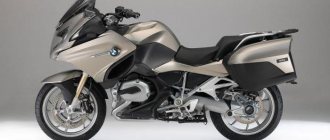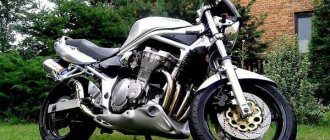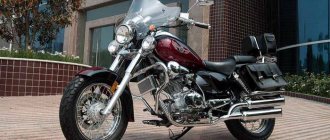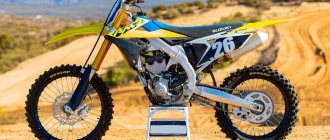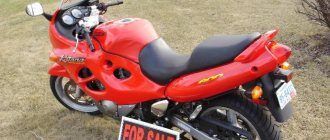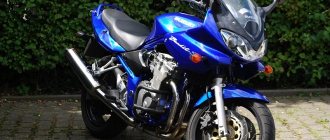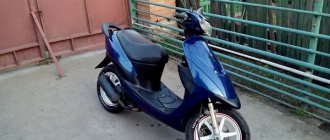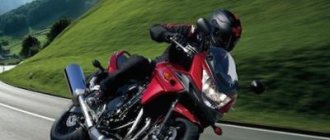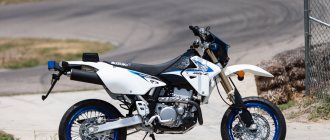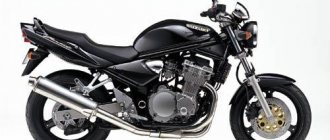Japanese motorcyclesSuzuki motorcycles
Thanks to the special attitude of Japanese engineers to the technology they design, they manage to bring novelty to even the most classic things.
Another confirmation of this was the SV400 motorcycle from Suzuki, which first rolled off the assembly line in 1999 .
This model, while maintaining the external image of its predecessors, incorporated the most modern trends in the construction of motorcycles of its time.
A distinctive feature of the bike was that it was intended exclusively for the Japanese market. In other countries, the model was called SV650.
There are some differences between the version intended for Japanese consumers and the one sold throughout the rest of the world (in terms of dimensions, weight, etc.). However, they are almost invisible when viewed from the outside.
SV Series
Model Suzuki SV400.
Model Suzuki SV650.
Model Suzuki SV1000.
As is customary, the lineup includes three bikes, differing in engine sizes:
- Suzuki SV 400 . The “younger” sister, production began with her. Planned for domestic Japanese markets only;
- Suzuki SV 650 launched a year later. This bike was exported to Europe, America, and Australia.
- Suzuki SV 1000 . Production of the older one opened in 2003 . The liter was also exported and was offered to experienced bikers for whom 650 was no longer enough.
Each model was divided into several modifications, but the main features of all bikes remained unchanged.
This is a naked car , a classic fit, a full set of lighting + mirrors, no standard trunk, and the presence of a title .
Model 400 existed on the assembly line for 8 years . During the entire production period, I received only minor cosmetic changes; the filling was not touched. The last bike rolled off the assembly line in 2006 .
Brief history of the model
Model:
Suzuki DR-Z400, Suzuki DR-Z400S, Suzuki DR-Z400E (all markets).
Factory designation:
DR-Z400Y, DR-Z400EY; DR-Z400SY.
2001 – no significant changes.
Model:
Suzuki DR-Z400, Suzuki DR-Z400S, Suzuki DR-Z400E (all markets).
Factory designation:
DR-Z400K1, DR-Z400EK1, DR-Z400SK1.
2002 – no significant changes.
Model:
Suzuki DR-Z400, Suzuki DR-Z400S, Suzuki DR-Z400E (all markets).
Factory designation:
DR-Z400K2, DR-Z400EK2, DR-Z400SK2.
2003 – no significant changes.
Model:
Suzuki DR-Z400, Suzuki DR-Z400S, Suzuki DR-Z400E (all markets).
Factory designation:
DR-Z400K3, DR-Z400EK3, DR-Z400SK3.
2004 – no significant changes.
Model:
Suzuki DR-Z400, Suzuki DR-Z400S, Suzuki DR-Z400E (all markets).
Factory designation:
DR-Z400K4, DR-Z400EK4, DR-Z400SK4.
Model:
Suzuki DR-Z400SM, Suzuki DR-Z400S, Suzuki DR-Z400E (all markets).
Factory designation:
DR-Z400SMK5, DR-Z400SMUK5; DR-Z400SK5, DR-Z400EK5.
Model:
Suzuki DR-Z400SM, Suzuki DR-Z400S, Suzuki DR-Z400E (all markets).
Factory designation:
DR-Z400SMK6, DR-Z400SMUK6; DR-Z400SK6, DR-Z400EK6.
Model:
Suzuki DR-Z400SM, Suzuki DR-Z400S, Suzuki DR-Z400E (all markets).
Factory designation:
DR-Z400SMK7, DR-Z400SMUK7; DR-Z400SK7, DR-Z400EK7.
Model:
Suzuki DR-Z400SM, Suzuki DR-Z400S (all markets).
Factory designation:
DR-Z400SMK8, DR-Z400SK8.
Model:
Suzuki DR-Z400SM, Suzuki DR-Z400S, Suzuki DR-Z400E (all markets).
Factory designation:
DR-Z400SMK9, DR-Z400SK9, DR-Z400EK9.
Model:
Suzuki DR-Z400SM, Suzuki DR-Z400S (North America, Australia).
Factory designation:
DR-Z400SML0, DR-Z400SL0.
Model:
Suzuki DR-Z400SM, Suzuki DR-Z400S (North America, Australia).
Factory designation:
DR-Z400SML1, DR-Z400SL1.
Model:
Suzuki DR-Z400SM, Suzuki DR-Z400S (North America, Australia).
Factory designation:
DR-Z400SML2, DR-Z400SL2.
Model:
Suzuki DR-Z400SM, Suzuki DR-Z400S (North America, Australia).
Factory designation:
DR-Z400SML3, DR-Z400SL3.
Model:
Suzuki DR-Z400SM, Suzuki DR-Z400S (North America, Australia).
Factory designation:
DR-Z400SML4, DR-Z400SL4.
Model:
Suzuki DR-Z400SM;
Suzuki DR-Z400S; Suzuki DR-Z400E (North America, Australia). Factory designation:
DR-Z400SML5; DR-Z400SL5; DR-Z400EL5.
Model:
Suzuki DR-Z400SM;
Suzuki DR-Z400S; Suzuki DR-Z400E (North America, Australia). Factory designation:
DR-Z400SML6; DR-Z400SL6; DR-Z400EL6.
Model:
Suzuki DR-Z400SM;
Suzuki DR-Z400S; Suzuki DR-Z400E (North America, Australia). Factory designation:
DR-Z400SML7; DR-Z400SL7; DR-Z400EL7.
Model:
Suzuki DR-Z400SM;
Suzuki DR-Z400S; Suzuki DR-Z400E (North America, Australia). Factory designation:
DR-Z400SML8; DR-Z400SL8; DR-Z400EL8.
Model:
Suzuki DR-Z400SM;
Suzuki DR-Z400S; Suzuki DR-Z400E (North America, Australia). Factory designation:
DR-Z400SML9; DR-Z400SL9; DR-Z400EL9.
Model:
Suzuki DR-Z400SM;
Suzuki DR-Z400S; Suzuki DR-Z400E (North America, Australia). Factory designation:
DR-Z400SMM0; DR-Z400SM0; DR-Z400EM0.
Specifications
The motorcycle received a classic 4-stroke engine with 2 cylinders.
Engine – right side view.
Engine – left view.
According to users, this 2-cylinder engine pulls better than others assembled with 4 cylinders. It is noted that there is no need to spin the engine in order to somehow drive. This is due to the following indicators:
- working volume - 399 cm3;
- number of cylinders - 2, L-shaped arrangement;
- number of cycles - 4;
- number of valves - 4;
- power - 53 hp;
- torque - 41 Nm;
- cooling - liquid;
- fuel supply - carburetor, Mikuni, 2x;
- ignition - transistor (TDI);
- start - electric starter;
- tank volume - 16 l.
Some reviews mention a V-twin engine. This model has an angle between the pistons of 900 , but the engine is tilted on its side. This arrangement is called L-shaped .
Transmission and clutch
The main drive is a classic chain drive.
The motorcycle was equipped with a 6-speed gearbox.
It shifted clearly, the pedal travel was within acceptable limits, and did not create any problems. Finding the right gear did not cause any problems; neutral was also caught immediately.
Users noted the well-chosen gear ratios. It was possible to start from a traffic light in second, maintain a speed of 80 km in fifth, or accelerate to 120 km/h .
- The clutch is multi-plate , oil bath , power transmission is via a simple cable .
- The main drive is traditional - chain .
Brakes
There is nothing unusual about the brake design. Both axles have hydraulically driven discs.
Front brakes.
Rear brakes.
An interesting detail is that the parameters of the staples vary from description to description. The instructions for the device provide the following information:
Front brakes:
- number of disks - 2;
- disc diameter - 290 mm;
- support - 2-piston.
Rear brakes:
- number of disks - 1;
- disc diameter - 240 mm;
- support - 1-piston.
The ABS system appeared on the line only in 2007 , a year after the end of production of the 400 , so it was not on this model. At the same time, the brakes have undergone one minor change. In the first bikes, one disc was installed on the front axle, which caused complaints from users. In 2000, they began to put a pair on it. There were no other changes !
Blog named after Zigger → How I improved the rear light
The idea to radically redesign the rear optics of the Suzuki SV400S appeared even before assembling the new battery. But it finally took shape at the same time as ordering suitable LEDs, it became roughly clear what, where and how it would be done.
I consider halogens to be a relic of antiquity; Chinese taillights with diodes were not satisfactory with their power and the overall inherent wretchedness of their design. Bonuses were promised to myself - shine more, eat less, and all that... The overall reliability of the system should increase for the company
Moreover, my version should also have turned out cheaper than ready-made Chinese ones) Be careful! Then there are a lot of letters and not all of them are clear!
Driving performance
Even the first trip to the SV400 is enough to change your opinion about the “400” as a defective class. This “esveshka” can definitely be called a full-fledged simulator of the “six hundred”.
The maximum speed also varies from edition to edition. If you look at the instructions - 180 km/h . Users noted that despite the insignificant power, such speed is gained easily and naturally, although the headwind greatly interferes.
Acceleration to hundreds
Acceleration from zero to 100 km is 5.5 seconds . According to users - something like this. It is curious that some sources call 4-4.3 sec .
Blog named after Zigger → How and why I made a lithium battery
I decided that I would dedicate my first post to something more interesting than how I got to this life))
The Suzuki SV400S '98 motorcycle I bought last fall almost immediately needed a new battery - the one that was instantly discharged did not always turn on the 35-watt xenon, and the starter turned somehow sluggishly and reluctantly. After another shameful start “from the pusher”, I went to the sites in search of a new battery. And it started working almost immediately - a new battery for my Susa from any decent manufacturer cost at least 3 thousand rubles. And this is for prehistoric lead batteries, low-capacity, heavy, with low current output! Many people know that most lead batteries have such an unpleasant “feature” - with a declared capacity of 12 Ah, only half the capacity can be safely used, i.e. about 6 Ah. Further discharge leads to accelerated degradation of the battery and its immediate replacement.
The exception is batteries from the “Deep Cycle” series - but how often have you seen such an inscription? ))) After digging around a little more on the Internet, I found a more interesting option - batteries assembled from LiFePo4 cells. Be careful! Lots of strange letters and pictures
Fuel consumption
Considering that the motorcycle was assembled only for the domestic markets of Japan, the consumption was indicated in its own way.
“At a constant speed of 60 km/h and the presence of a second number, no more than 2.7 per 100 km is guaranteed.”
According to Russian owners, even in a large metropolis (Moscow), consumption does not exceed 5 liters . When driving on the highway it can drop to 3 liters . Specific figures depend on driving conditions, the quality of the road surface and the technical condition of the vehicle.
Owner reviews
I rode the Suzuki DRZ for two full seasons, sold it with relief, and now I’ll tell you why. The motorcycle is truly universal, truly tenacious, but it is somehow too average, as if without a soul. And it’s just strange - you need to turn the engine to cheerfully drive, but you can only drive on the highway. But we seem to have enduro, don’t we? But there is no tractor traction on the lower parts. Tops are not so needed off-road, but we don’t have bottoms - only tops. As a result, you can powerfully push across the field, but making your way through the forest between the trees is stupidly boring, it’s not for that bike. Ivan, Krasnodar.
The best model from Suzuki!! I used to ride a Honda XR250, but, firstly, I wanted to increase the cubic capacity, and secondly, I decided to buy a motard. The choice ultimately fell on Suzuki, the 2011 DR Z 400 SM. I took it with a mileage of 15k km, it doesn’t seem to be twisted, at least this is indicated by indirect signs. After a season, I can confidently say that Suzuki engineers know their stuff and they’re on fire. It goes everywhere, any way you like, even on the ground, even on the road, steering is elementary. But the character is evil, constantly provokes, so I strictly do not recommend it to beginners - you can accidentally kill yourself due to inexperience. Rinat, Vologda.
I was choosing between the Suzuki DRZ and the Chinese enduro, I took the Japanese one and was not mistaken. The motor is old, but problem-free, it doesn’t break at all. The downside is that the seat is made of oak and the tank is small. The rest is a complete plus. Andrey, Lobnya.
Modifications
From the very beginning of production, the model was divided into 2 directions.
- Suzuki SV 400 is a classic naked bike . A round headlight, a steering wheel that allows you to sit in a classic manner, comfortable footrests.
- Suzuki SV 400S - version sport. Front fairing, windshield (low), double headlight in the tradition of sports bikes. Clip-ons are installed instead of the steering wheel, and the footpegs are also raised for a sporty style.
Suzuki SV 400S – front view.
Suzuki SV 400S – side view.
Suzuki SV 400S – rear view.
This was not included in the classic modifications, but upon order, the user could receive a tank of a different shape, allowing him to “lie down” on it.
Photo gallery
Suzuki SV 400 S is a small, maneuverable sportbike that can give a head start to many models. Despite its apparent simplicity, the motorcycle gives its owner maximum drive and extreme sports! Let's take a look at its appearance.
and competitors
The bike also had competitors, but interestingly, other Japanese presented models with larger cubic capacity. This was explained by the fact that the SV400 pulls much better than other models, and in order to somehow compare, you need to find a more powerful model.
Fazer 600.
Honda CB500.
Kawasaki ER-5.
- Kawasaki's answer was the ER-5 . Export option. The model had fewer horses, but consumed more fuel. Interestingly, the SV400 is a Japanese version. Kawasaki had an ER-4 , also intended for Japan only, but they wisely kept silent about it. It was not beneficial to compare it with Suzuki.
- Honda also submitted its response. It was the Honda CB500 , and earlier the Honda Bros 650 (aka Honda NTV 650 Revere, Honda NT650 Hawk GT).
- Yamaxa at that moment was engaged in touring-enduro and road work, especially since it did not want to be distracted by small-capacity ones. To the question, how can this be? She answered - our road worker is Fazer . If you want, buy it. True, a couple of years later, noticing the user’s interest, they released Fazer 600 (FZ6) . But it, just like the first one, based on the R6 sport, had an eye on a completely different type of user, although, like the Suzuki, it was considered a naked bike.
Travel → Perm-Peter 2011: there and back with adventures. (part 1)
The other day I found memories of a motorcycle trip recorded in 2011. I wrote it out of emotion after returning (as an accompanying text to the photo report), but then I never posted it anywhere. Now I’m attacked by nostalgia for that motorcycle season, motorcycle toxicosis has set in, and I decided to get those notes out of the dusty archive. I share with you that summer
